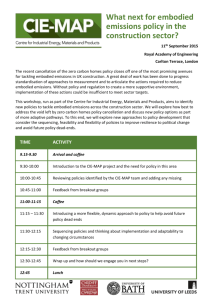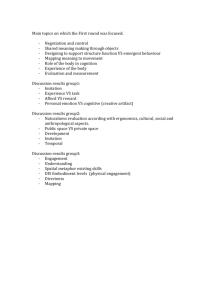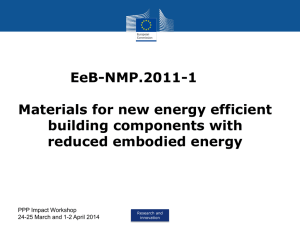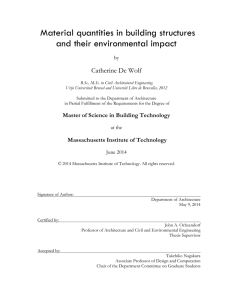Construction Sector
advertisement
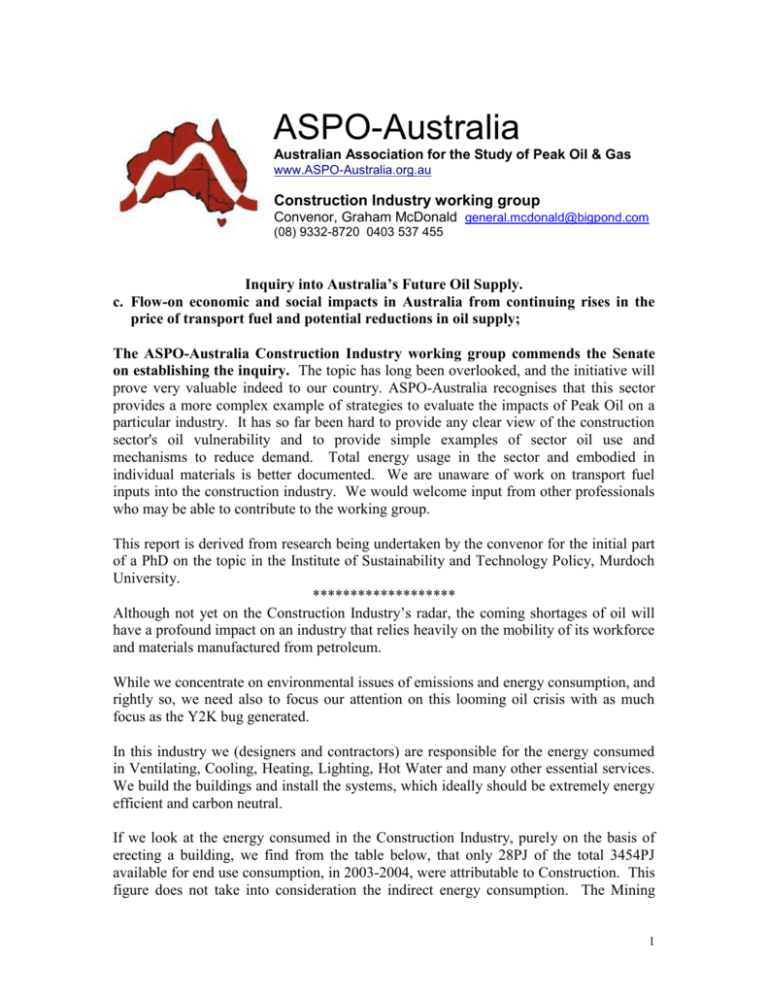
ASPO-Australia Australian Association for the Study of Peak Oil & Gas www.ASPO-Australia.org.au Construction Industry working group Convenor, Graham McDonald general.mcdonald@bigpond.com (08) 9332-8720 0403 537 455 Inquiry into Australia’s Future Oil Supply. c. Flow-on economic and social impacts in Australia from continuing rises in the price of transport fuel and potential reductions in oil supply; The ASPO-Australia Construction Industry working group commends the Senate on establishing the inquiry. The topic has long been overlooked, and the initiative will prove very valuable indeed to our country. ASPO-Australia recognises that this sector provides a more complex example of strategies to evaluate the impacts of Peak Oil on a particular industry. It has so far been hard to provide any clear view of the construction sector's oil vulnerability and to provide simple examples of sector oil use and mechanisms to reduce demand. Total energy usage in the sector and embodied in individual materials is better documented. We are unaware of work on transport fuel inputs into the construction industry. We would welcome input from other professionals who may be able to contribute to the working group. This report is derived from research being undertaken by the convenor for the initial part of a PhD on the topic in the Institute of Sustainability and Technology Policy, Murdoch University. ******************* Although not yet on the Construction Industry’s radar, the coming shortages of oil will have a profound impact on an industry that relies heavily on the mobility of its workforce and materials manufactured from petroleum. While we concentrate on environmental issues of emissions and energy consumption, and rightly so, we need also to focus our attention on this looming oil crisis with as much focus as the Y2K bug generated. In this industry we (designers and contractors) are responsible for the energy consumed in Ventilating, Cooling, Heating, Lighting, Hot Water and many other essential services. We build the buildings and install the systems, which ideally should be extremely energy efficient and carbon neutral. If we look at the energy consumed in the Construction Industry, purely on the basis of erecting a building, we find from the table below, that only 28PJ of the total 3454PJ available for end use consumption, in 2003-2004, were attributable to Construction. This figure does not take into consideration the indirect energy consumption. The Mining 1 Industry consumed 314PJ in the same year and approximately 50% by weight of all materials taken from the Earth’s crust are used in the Construction Industry. Our energy export and input statistics are also misquoted. If we are a main exporter of minerals which are converted to useable products overseas and returned to our shores for local consumption, then we have indeed imported the energy content of that material. ENERGY END-USE, By sector Agriculture Mining Manufacturing Construction Transport(a) Commercial(b) Residential(c) Other(d) Total 1998-99 PJ 68 267 1004 49 1217 212 386 58 3261 2002-03 PJ 106 296 1122 28 1207 236 413 60 3467 2003-04 PJ 95 314 1138 28 1251 235 421 63 3545 (a) Includes all transport use, including household motor vehicle use. (b) Includes wholesale and retail trade, communications,finance and insurance, property and business services, government administration and defence, education, health and community services, cultural and recreational services, and personal and other services, along with water, sewerage and drainage. (c) Transport use by households is included in transport. (d) Includes lubricants and greases, bitumen and solvents, as well as energy consumption in the gas production and distribution industries. Source: ABARE 2006 Year Book. Also, far more energy is consumed in the manufacturing process from raw minerals to finished product, as the table suggests. The Construction Industry is now more conscious of the energy needed to extract the raw material, convert it to a finished product and transfer it to site. It terms this value as Embodied energy. On average 1000 GJ of embodied energy is contained in each household. This is sufficient energy to provide a comfortable environment for 15 years for the life of the property. Some buildings are far more complex, and at the other end of the spectrum, it is questionable whether a nuclear power station is capable of producing enough energy to build, operate and decommission itself. Just look at the expense the tax payers of the UK have in relation to the decommissioning of Dounreay Nuclear Power Station in the North of Scotland. Life Cycle Analysis is one method of assessing the whole energy content of a building but it is costly to undertake these studies. Ideally the Government should insist on a proper analysis of each building during the planning stage. The importance of planning early for reductions in oil supply can not be overstated. It takes several years to bring new products to the marketplace. Cable insulation, thermal insulation, fabrics, piping and a host of other items are all made using petroleum as a 2 feedstock. The construction industry alone consumes over 50% of all PVC manufactured in the world. There are few alternatives to cheap and corrosion free plastics in some areas of construction. Investment in research and development for large scale alternative hydrocarbon based feedstocks is essential. Moreover plastics are large consumers of energy during the manufacturing processes. The Embodied energy for plastics as noted in the table below is considerably higher than materials such as glass concrete and wood. Typical figures for some Australian materials are given in the table below. Generally, the more highly processed a material is the higher its embodied energy. These figures should be used with caution, as sourcing these products in Western Australia, for instance, will consume a different amount of energy as sourcing them in New South Wales. MATERIAL Kiln dried sawn softwood Kiln dried sawn hardwood Air dried sawn hardwood MDF Plywood Glue-laminated timber Plastics - general PVC Synthetic rubber Acrylic paint Imported dimension granite Local dimension granite Gypsum plaster Plasterboard Cement Insitu Concrete Precast tilt-up concrete Clay bricks Concrete blocks Glass Aluminium Copper Galvanised steel EMBODIED ENERGY MJ/kg 3.4 2.0 0.5 11.3 10.4 11.0 90.0 80.0 110.0 61.5 13.9 5.9 2.9 4.4 5.6 1.9 1.9 2.5 1.5 12.7 170.0 100.0 38.0 Source: Dr W Lawson, The University of New South Wales 1996. The above table does not differentiate between the types of fuels used in the process of converting the raw material to the finished product. Though timber is a small consumer of energy it is highly dependent on petroleum-powered tools and vehicles in order to 3 manage the forests effectively and bring the product to the marketplace. It is inevitable that the above figures will change, as oil becomes scarcer. We need a method of categorising the products we use to be able to select those that are made from recycled materials, substantially reducing the embodied energy. The location of the building will greatly increase the energy cost. There are many major buildings built on remote sites because the capital cost of the project was only affordable if the site was inexpensive. As most city sites are extremely expensive property developers are forced out to the fringe of the city, forming commercial and industrial parks in the suburbs. The dilemma is that it is dearer for a person to live in the city, despite the obvious reduction in travelling costs. The Australian Building Code Board provides, through the Building Code of Australia, minimum energy performance standards, which are improving year on year. Designers are keen to promote energy efficient design and will welcome any statutory requirements for landlords to adopt more energy conserving measures. “The energy available in an ecosystem is one of the most important factors in determining its carrying capacity”,Richard Heinberg’s The Party’s Over. For humans and most species on earth this is food-energy. Like the rabbit population in Australia, with no predators and an unlimited food supply, the human race will continue to expand. With this expansion there is a need for additional shelter, light, warmth, cooling and means of cooking. However, in a decade or so, or certainly in my children’s lifetime, we will come to understand the true importance of petroleum products that goes beyond the energy boundaries – to products we all take for granted – plastics, fertilisers and pesticides. 4
